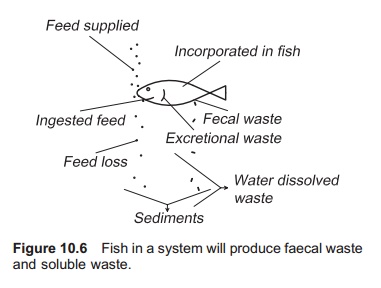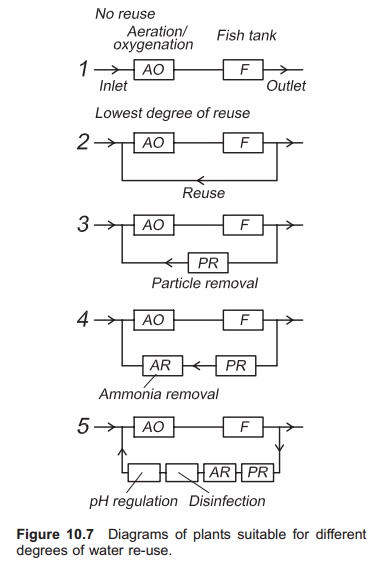Chapter: Aquaculture Engineering : Recirculationand Water Re-use Systems
Components in a Aquaculture re-use system
Components in a re-use system
Fish require oxygen for
respiration and produce faecal waste, urine and dissolved substances released
over the gills (Fig. 10.6). The reasons for treating the water are therefore
either to add new substances (oxygen) or to dilute waste products. The
components required for water treatment, either for addition or removal of
substances in the re-use circuit, can be calculated based on the equation given
earlier in the chapter, and depend on species, size and growth rate. The usual
order of necessary water treatment efforts is shown below, and compared to what
happens in a tank were the inlet water flow is reduced (Fig. 10.7). To reduce
the amount of incoming water to the tank is actually the same as using a re-use
system without any purification units such as particle or ammonia removal
filters.

If the water is re-used without
any treatment, the effect is the same as reducing the water inlet volume. The
first problem is that the concentration of oxygen in the outlet water will be
below recommended values; the main reason for adding water to the tank is to
have an outlet oxygen level high enough to achieve maximum growth of the fish.
If this water is re-used directly, the oxygen concentration will be too low and
will result in growth reduction. If the reduction is excessive, mortality will
occur; values are species-dependent. There are numerous ways to increase the
concentration of oxygen in the water, including the usual method of adding an
aerator before the inlet to the tank system. In addition, after the water has
been aerated up to near 100% saturation pure oxygen can be added to increase
the concentration further (supersaturation). Both aeration and oxygenation can
also be done directly into the

If aeration/oxygenation is
carried out, the amount of water added to the system can be reduced. This new
value is normally set by the acceptable SS concentration, but may vary with
organism and species. The water flow-through the tanks must now be sufficiently
high to dilute the SS concentration to avoid reduction in growth. Methods of
achieving this are given, but usually the outlet water is sent over some kind
of micro-strainer where particles are removed before the water is recycled.
Another way to deal with this is to use a dual drain outlet with a separate
particle outlet from which the SS are drawn off in 1–5% of the total water flow
enabling the rest of the water to be re-used without any other treatment.
If the amount of new water is
reduced significantly, the next problem that may occur is accumulation of CO2
in the tank to critical levels, because the fish release CO2 through
the gills as a waste product of metabolism and the concentration in the water
increases. Tank aeration or piping the water through an aerator are two
possible solutions to this problem; however, normally this has already been
done to increase the concentration of oxygen in the water. If continuously high
concentrations of CO2 are experienced a vacuum aerator may be used
because this is more effective for removing CO2 than a traditional
aerator designed to increase the oxygen concentration.
Reduction of the water flow into
the tank can lead to excessive concentrations of NH3 (actually TAN,
because there is a connection between NH3 and NH4+ levels which depends on the pH). The normal method of reducing
the NH3 concentration in the system is to use a biofilter in the
re-use circuit that transforms ammonia to less harmful nitrate (NO3).
The normal units included in a
re-use system are described above. However, other problems may occur when
adding a small amount of new water or with a high degree of re-use. This
problem mainly concerns the components in the re-use circuit: the complexity of
the system means that a good knowl-edge of water quality and the way in which
differ-ent water quality parameters influence each other is very important.
There will be a drop in the pH in
the system with high degrees of re-use. The reasons for this are that the
biofilter process release H+ ions to the water, and that CO2
is released by the fish. Therefore pH regulation must be included in the water
treatment for the system, for instance addition of lime.
When having high percentages of
water re-use (>99%), high fish densities and a
biofilter in the system for ammonia removal, the concentration of nitrate (NO3)
can reach values that can be toxic to the fish if it is not removed. Usually a
denitrification filter is added to the re-use circuit. Here nitrate is
transformed to nitrogen gas (N2) that can be removed by aeration.
High degrees of water re-use will
normally also increase the total number of bacteria, some of which might be
pathogenic. It is therefore normal to include disinfection in the circuit, for
instance UV irradiation.
Related Topics